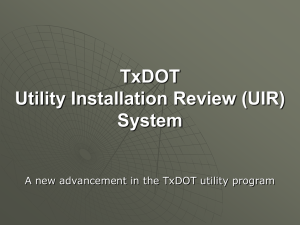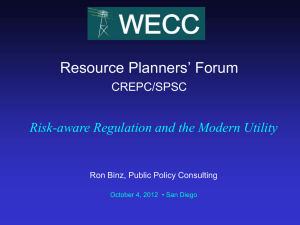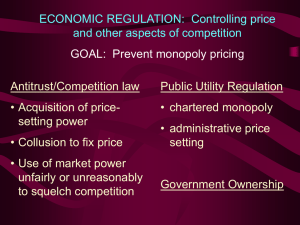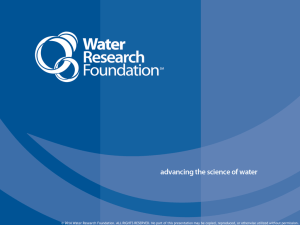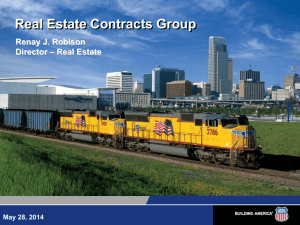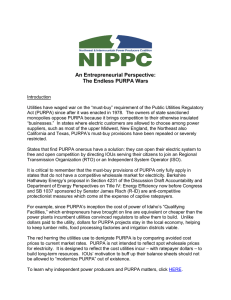The Foundations of Electric Utility Regulation
advertisement
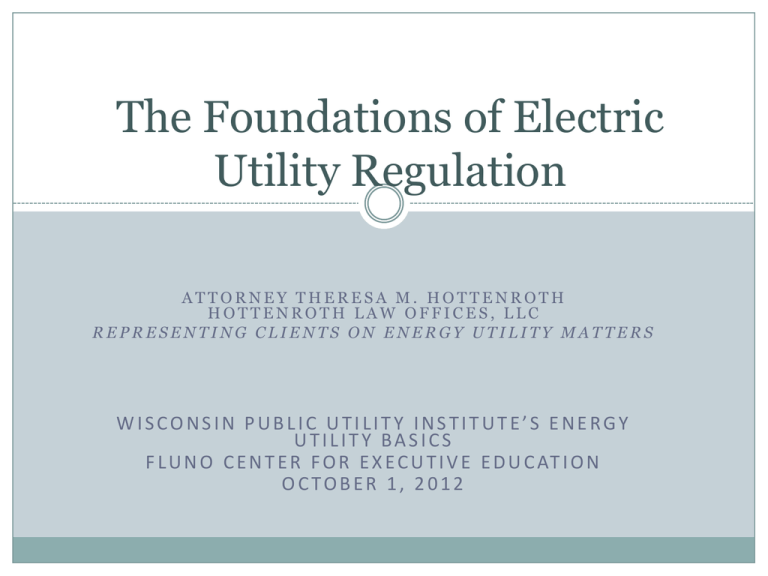
The Foundations of Electric Utility Regulation ATTORNEY THERESA M. HOTTENROTH HOTTENROTH LAW OFFICES, LLC REPRESENTING CLIENTS ON ENERGY UTILITY MATTERS WISCONSIN PUBLIC UTILITY INSTITUTE’S ENERGY UTILITY BASICS F L U N O C E N T E R F O R E X E C U T I V E E D U C AT I O N OCTOBER 1, 2012 The Legal Foundation of Public Utility Regulation English common law, 1600s – Notwithstanding the rights associated with private ownership of property, sometimes a private owner’s business becomes “clothed with a public interest” and ceases to be solely private; the government assumes a role in protecting that public interest. The Legal Foundation of Public Utility Regulation “There is no doubt that the general principle is favored, both in law and in justice, that every man may fix what price he pleases upon his own property, or the use of it; but if for a particular purpose the public have the right to resort to his premises and make use of them, and he have a monopoly in them for that purpose, if he will take the benefit of that monopoly, he must, as an equivalent, perform the duty attached to it on reasonable terms.” - Lord Ellenborough, Aldnut v. Ingles Early Examples of Regulation of Monopolies Ferry boats Toll roads United States Constitution All governmental powers are reserved to the states except for the powers conferred on Congress by the Constitution. The Interstate Commerce Clause authorizes Congress to “regulate commerce…among the several states.” Article V of the Bill of Rights: “No person shall…be deprived of life, liberty, or property, without due process of law; nor shall private property be taken for public use, without just compensation.” States’ “Police Powers” Within the limits of state vs. federal jurisdiction, states have authority to regulate business as necessary to safeguard the health, safety, and welfare of the citizenry. Federal Preemption Doctrine States and the federal government may have complementary regulatory authority (e.g., a state may regulate intrastate aspects of an activity under its police powers, while the federal government regulates interstate commerce). In the event of a conflict between state and federal law, federal law trumps state law. In some cases, federal law will “occupy the field” and states may not exercise any authority. Economic Foundations of Regulation Importance of product/service for economic growth Absence of workable competitive market “Natural monopoly” The “Public” in Public Utility What is a Public Utility? “…a business organization deemed by law to be vested with public interest usually because of monopoly privileges and so subject to public regulation such as fixing rates, standards of service and provision of facilities.” - Webster’s 3rd New International Dictionary, Unabridged (1993) Key elements: public interest and monopoly privileges The Railroad Precedent Railroads incorporated by acts of Congress and thereby authorized to construct road through states Within state, part of the railroad’s business involves carrying persons and property from point to point Since the Constitution doesn’t give Congress the power to control this business, the state exercises its police power over the intrastate business When railroad stockholders challenge the right of the state to regulate the business, the court replies that the company (and its stockholders) “must have known” that the state had and would exercise this control But… “The power to regulate is not a power to destroy, and the limitation is not the equivalent to confiscation. Under the pretext of regulating fares and freights, the State cannot require a railroad corporation to carry persons or property without reward; neither can it do that which in law amounts to taking of private property for public use, without just compensation or without due process of law.” - Smyth v. Ames, 160 U.S. 466 (1898) (quoting Railroad Commission, 116 U.S. 307) A Brief History of Electric Utility Regulation - or – How Did We Get Here? In The Beginning… Inventors and investors establish many different, competing companies Competition by locality and by technology Major uses: City street lighting Streetcars Interurban railways Followed By… Cycles of success and failure, new entrants into business, consolidation of the players Expansion into providing power for commercial and industrial uses, residential appliances Better understanding of extremely capital-intensive nature of providing electricity Better understanding of need to serve load across multiple sectors – evening lighting and residential, daytime commercial and industrial – to make the enterprise economically efficient City-by-city franchises – sometimes exclusive, sometimes not And Eventually… Concerns over corruption and struggle between local and state political control Concerns over economic and political power of corporations Concerns over economic inefficiency of decentralized competitive model Leading To… Expansion, interconnection, and consolidation of utilities Vision of electric utilities as natural monopolies and necessary for economic development Creation of state commissions to regulate public utilities Leading To… 1907: Wisconsin Railroad Commission is restructured as the first state commission with authority to regulate electric utilities’ rates, set standards of service, and regulate issuance of securities. 1930: Every state except Delaware has a utility regulatory commission. The Regulatory Compact Bargain between regulator and regulated Private property put to use in the public interest Government will protect the interests of both the consumer and the supplier Supplier has both rights and responsibilities Rights Holder of natural monopoly Franchise to serve defined territory Can charge rates to cover the reasonable cost of service Entitled to receive a fair and reasonable return on investment Responsibilities Obligation to serve all customers in territory No discrimination in providing service or in charging rates Provide safe and reliable service Do not build unnecessary facilities or incur costs for unnecessary services Open the books to regulators The Ascendancy of Federal Regulation 1877 1914 1920 1933 1934 1935 Interstate Commerce Act Federal Trade Commission Federal Water Power Act Federal Power Commission (FPC) Securities Act Securities and Exchange Act Public Utility Act Public Utility Holding Company Act of 1935 Federal Power Act Appendix Federal Power Act (1935) FPC jurisdiction expanded to include transmission and “sale for resale” of electricity FPC authorized to prescribe accounting methods and depreciation rates Annual reports required Public Utility Holding Company Act (1935) Securities & Exchange Commission regulates utility holding companies Restrictions on securities issuances Restrictions on sales, loans and asset transfers between companies in holding company system Natural Energy Act of 1978 Public Utilities Regulatory Policy Act (PURPA) Natural Gas Policy Act PURPA - Goals Conservation and fuel efficiency Development of new technologies Rational pricing PURPA – Key Elements Required rates to be based on cost of service Encouraged time-of-day pricing – off-peak and on- peak Required interruptible rates Created incentive for small power producers – “Qualified Facilities” (QFs) Required utilities to buy power from QFs if price is below the utility’s “avoided cost” The Beginnings of Deregulation Energy Policy Act of 1992 Exempt Wholesale Generators (EWGs) – can sell power directly into wholesale market, not subject to PUHCA and PURPA constraints Open access to transmission system is required – eliminate the transmission owner’s ability to assert monopoly power over the grid EWGs sell their product directly into interstate commerce and thus are regulated by the federal government – immune from state regulation over rates, terms of service Energy Policy Act of 2005 Repeals many restrictions of PUHCA 1935 and PURPA Simultaneously expands FERC’s jurisdiction – e.g., PUHCA 2005 Federal Energy Regulatory Commission (FERC) Successor to Federal Power Commission Numerous orders designed to create competitive wholesale power market: Functional separation of generation and transmission Equal, open access to the transmission grid Regional transmission organizations Reliability standards State-by-State Restructuring of Electric Utility Regulation Retail competition? Separate generation, transmission, and distribution? Change pricing mechanisms? Promote use of renewable energy sources Speed Bumps on the Road to Restructuring Enron and the California market crisis Reliability crises Investments needed in new utility infrastructure Environmental concerns Customers did not see reduced rates Sources of the Law State and federal statutes express legislators’ policy State and federal commissions and agencies adopt administrative rules and regulations Courts decide whether the Constitution or statute requires (or prohibits) certain conduct State and federal commissions issue quasijudicial orders and decisions State Utility Regulators Jurisdiction over retail electric service within state Regulatory authority over investor-owned utilities, electric cooperatives, municipal utilities varies depending on statutory scheme Typical areas of responsibility: Rate setting Approving construction projects Establishing service standards Establishing and enforcing accounting and financial standards Authorizing the issuance of securities Federal Energy Regulatory Commission Regulates the transmission of electricity in interstate commerce Regulates wholesale sales of electricity in interstate commerce Licenses and inspects hydroelectric projects Establishes and enforces accounting and financial standards and requirements Monitors and investigates energy markets Some Key Issues in Current Regulation Reduce energy consumption Utility involvement in energy efficiency/demand-side management Encouraging a supplier to sell less of its product Develop new energy sources, especially renewables Reduce environmental effects of energy production and use Maintain financial viability of utility while controlling consumers’ costs Other Regulatory Bodies Federal: Nuclear Regulatory Commission Environmental Protection Agency North American Electric Reliability Council/North American Electric Reliability Organization Department of Defense-Corps of Engineers Department of Energy (besides FERC) Department of Homeland Security Securities and Exchange Commission Federal Trade Commission Department of Justice-Antitrust Division Other Regulatory Bodies State: Environmental Agencies Local Governments Others




